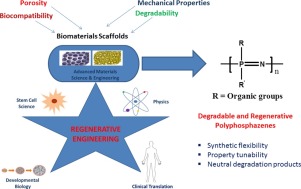Progress in Polymer Science ( IF 27.1 ) Pub Date : 2019-08-09 , DOI: 10.1016/j.progpolymsci.2019.101146 Kenneth S Ogueri 1, 2 , Harry R Allcock 3, 4 , Cato T Laurencin 1, 2, 5, 6, 7

|
New fields such as regenerative engineering have driven the design of advanced biomaterials with a wide range of properties. Regenerative engineering is a multidisciplinary approach that integrates the fields of advanced materials science and engineering, stem cell science, physics, developmental biology, and clinical translation for the regeneration of complex tissues. The complexity and demands of this innovative approach have motivated the synthesis of new polymeric materials that can be customized to meet application-specific needs. Polyphosphazene polymers represent this fundamental change and are gaining renewed interest as biomaterials due to their outstanding synthetic flexibility, neutral bioactivity (buffering degradation products), and tunable properties across the range. Polyphosphazenes are a unique class of polymers composed of an inorganic backbone with alternating phosphorus and nitrogen atoms. Each phosphorus atom bears two substituents, with a wide variety of side groups available for property optimization. Polyphosphazenes have been investigated as potential biomaterials for regenerative engineering. Polyphosphazenes for use in regenerative applications have evolved as a class to include different generations of degradable polymers. The first generation of polyphosphazenes for tissue regeneration entailed the use of hydrolytically active side groups such as imidazole, lactate, glycolate, glucosyl, or glyceryl groups. These side groups were selected based on their ability to sensitize the polymer backbone to hydrolysis, which allowed them to break down into non-toxic small molecules that could be metabolized or excreted. The second generation of degradable polyphosphazenes developed consisted of polymers with amino acid ester side groups. When blended with poly (lactic acid-co-glycolic acid) (PLGA), the feasibility of neutralizing acidic degradation products of PLGA was demonstrated. The blends formed were mostly partially miscible. The desire to improve miscibility led to the design of the third generation of degradable polyphosphazenes by incorporating dipeptide side groups which impart significant hydrogen bonding capability to the polymer for the formation of completely miscible polyphosphazene-PLGA blends. Blend system of the dipeptide-based polyphosphazenes and PLGA exhibit a unique degradation behavior that allows the formation of interconnected porous structures upon degradation. These inherent pore-forming properties have distinguished degradable polyphosphazenes as a potentially important class of biomaterials for further study. The design considerations and strategies for the different generations of degradable polyphosphazenes and future directions are discussed.
中文翻译:

新一代可生物降解和再生聚磷腈聚合物及其与聚(乳酸-乙醇酸)的共混物
再生工程等新领域推动了具有多种特性的先进生物材料的设计。再生工程是一种多学科方法,整合了先进材料科学与工程、干细胞科学、物理学、发育生物学和临床转化等领域,用于复杂组织的再生。这种创新方法的复杂性和要求激发了新型聚合物材料的合成,这些材料可以定制以满足特定应用的需求。聚磷腈聚合物代表了这一根本性变化,并且由于其出色的合成灵活性、中性生物活性(缓冲降解产物)和整个范围内的可调特性,作为生物材料重新获得了人们的兴趣。聚磷腈是一类独特的聚合物,由具有交替的磷和氮原子的无机主链组成。每个磷原子带有两个取代基,具有多种侧基可用于性能优化。聚磷腈已被研究作为再生工程的潜在生物材料。用于再生应用的聚磷腈已发展为一类,包括不同代的可降解聚合物。用于组织再生的第一代聚磷腈需要使用具有水解活性的侧基,例如咪唑、乳酸酯、乙醇酸酯、葡萄糖基或甘油基。这些侧基的选择是基于它们使聚合物主链对水解敏感的能力,这使得它们能够分解成可以代谢或排泄的无毒小分子。开发的第二代可降解聚磷腈由带有氨基酸酯侧基的聚合物组成。当与聚乳酸-乙醇酸 (PLGA) 共混时,中和 PLGA 酸性降解产物的可行性得到了证明。形成的共混物大部分是部分混溶的。为了提高混溶性,人们设计了第三代可降解聚磷腈,通过引入二肽侧基,赋予聚合物显着的氢键结合能力,形成完全混溶的聚磷腈-PLGA 共混物。基于二肽的聚磷腈和 PLGA 的共混体系表现出独特的降解行为,可以在降解时形成互连的多孔结构。这些固有的成孔特性使可降解聚磷腈成为一类潜在的重要生物材料,有待进一步研究。讨论了不同代可降解聚磷腈的设计考虑和策略以及未来的方向。



























 京公网安备 11010802027423号
京公网安备 11010802027423号